Abstract
It has been discovered that miR-133a-3p acts as a tumor suppressor in bladder cancer (BC). Nevertheless, the function of miR-133a-3p in BC remains unclarified. Thus, we carried out this study to validate the expression of miR-133a-3p in BC and provide insights into the molecular mechanism underlying it. To assess the expression of miR-133a-3p in BC, we searched eligible studies from literature and Gene expression Omnibus (GEO) to perform a meta-analysis. We also plotted the summary receiver operating characteristic (SROC) curve to evaluate the diagnostic ability of miR-133a-3p in BC. Additionally, the potential target genes of miR-133a-3p were acquired from 14 online software programs and GEO database. Protein-protein interaction (PPI) network was created to identify the hub genes. Then, Gene Ontology (GO) functional annotation analysis and Kyoto Encyclopedia of Genes and Genomes (KEGG) pathway analysis were carried out to investigate the regulatory network of the target genes. From the meta-analysis, miR-133a-3p was remarkably downregulated in BC tissues compared with that in non-cancer tissues (standard mean difference =−3.84, 95% confidence interval =−6.99–0.29). Moreover, results from SROC suggested that miR-133a-3p exhibited the ability to diagnose BC (area under curve =0.8418). As for the bioinformatics study, 488 genes were chosen as the potential targets of miR-133a-3p in BC, among which 10 genes were defined as hub genes (all degrees >5). Further GO and KEGG pathway analysis indicated that the target genes of miR-133a-3p aggregated in specific biological process and pathways. In conclusion, miR-133a-3p possessed great diagnostic potential with its downregulation in BC, and miR-133a-3p might serve as a novel biomarker for BC.
Introduction
Bladder cancer (BC) is the most common malignant tumor in the urinary tract neoplasms with a high prevalence in the world, posing a threat to patients.Citation1–Citation10 According to the statistical data from Siegel et al, there were estimated 79,030 new cases of BC and 16,870 BC deaths in 2017.Citation11 BC can be divided into two types: non-muscle-invasive BC and muscle-invasive BC. Treatment for non-muscle-invasive tumor consisted of transurethral resection of bladder tumor (TURBT) and post-TURBT adjuvant therapy based on risk level, while radical cystectomy and cisplatin-based chemotherapy constitute major treatments for muscle-invasive BC.Citation12–Citation14 However, muscle-invasive BC had high recurrence and distant metastasis in patients undergoing the aforementioned treatment.Citation15 Therefore, there is a urgent need to seek a novel biomarker for BC.
MicroRNA (miRNA) is an endogenous non-coding small single-stranded RNA in eukaryotes, about 19–24 nucleotides in length. This small, non-coding molecule inhibited the expression of downstream mRNAs either by degrading mRNAs or suppressing the translation process by binding to the 3′untranslated site of target mRNAs.Citation16–Citation21 Previous researches revealed that miRNAs are involved in fundamental biological process such as proliferation, differentiation, apoptosis, metabolism and immunity, playing roles of oncogenes or tumor suppressor genes in a wide type of human cancers.Citation22–Citation24
MiR-133a-3p, a member of the miRNA family, plays a pivotal role in the oncogenesis of various cancers, such as ovarian cancer, colorectal cancer, breast cancer and prostate cancer.Citation25–Citation28 Although several studies reported that miR-133a-3p was downregulated in BC and acted as a tumor suppressor by interacting with related molecules including IGF1R, MMP-9 and EGFR,Citation29–Citation33 the exact mechanism of miR-133a-3p in the pathogenesis of BC was far from elucidated. Therefore, in the present study, we assessed the expression and diagnostic significance of miR-133a-3p in BC by conducting meta-analysis of literature and GSE datasets. Furthermore, bioinformatics study was performed to probe into the underlying molecular mechanism of miR-133a-3p in BC.
Materials and methods
The extraction of literature studies
To validate the expression of miR-133a-3p in BC, we conducted a systematic search in the following database: PubMed, Chinese VIP, CNKI, WanFang database, SinoMed, Embase, Web of science, Science Direct and Wiley Online Library. The search was conducted with the following keywords: (miR-133a OR miRNA-133a OR microRNA-133a OR miR-133a OR miRNA-133a OR microRNA-133a OR “miR-133a” OR “miRNA-133a” OR “microRNA-133a”) AND (malignan* OR cancer OR tumor OR tumour OR neoplas* OR carcinoma) AND (bladder OR urinary OR BC). Studies that met the following inclusion criteria were included in our studies: 1) studies provided the expression data of miR-133a-3p between BC and non-cancer tissues, 2) the subjects of the experiment were human beings and 3) the studies should be published in English or Chinese. In addition, studies were excluded according to the following exclusion criteria: 1) the expression of miR-133a-3p was detected in cell lines, 2) there were no non-cancer tissues as the control for the BC tissues and 3) the articles belonged to the types of review, meta-analysis, letters, commentaries and conference abstracts. After the selection of qualified literature studies, the basic information and data were extracted from each of the included studies: first author, ID, year of publication, country, ethnicity of the samples, sample sizes of the experimental and control group, male and female population in experimental and control group, types of specimen, types of experiment, platform and the mean (M) and standard deviation (SD) of miR-133a-3p expression in experimental and control group. The experimental design of the paper is presented in .
Figure 1 The experimental design of the paper.
Abbreviations: BC, bladder cancer; GO, gene ontology; GEO, Gene expression Omnibus; PPI, protein-protein interaction; KEGG, Kyoto Encyclopedia of Genes and Genomes.
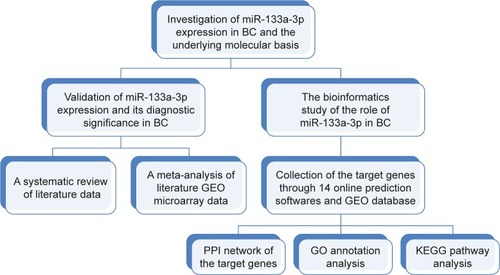
Meta-analysis
Chip selection and data extraction
Apart from literature database, Gene expression Omnibus (GEO) database proved to be a powerful tool to mine the expression of miRNAs in human cancers. Thus, we also searched GEO database to investigate miR-133a-3p expression in BC. Eligible chip data for the meta-analysis were searched with the following strategies: (miR-133a OR miRNA-133a OR microRNA-133a OR miR-133a OR miRNA-133a OR microRNA-133a OR “miR-133a” OR “miRNA-133a” OR “microRNA-133a”) AND (malignan* OR cancer OR tumor OR tumour OR neoplas* OR carcinoma). The inclusion and exclusion criteria of chip data were the same as those of literature studies. The selected chip data were also extracted for the following basic information and data: first author, ID, year of publication, country, ethnicity of the samples, sample sizes of the experimental and control group, male and female population in experimental and control group, types of specimen, types of experiment, platform and the mean (M) and standard deviation (SD) of miR-133a-3p expression in experimental and control groups. The expression patterns of miR-133a-3p in BC and non-cancer tissues from literature studies and GEO microarray chips were visualized by GraphPad Prism 5.
Statistical analysis
Pooled standard mean difference (SMD) with 95% confidential interval (CI) of miR-133a-3p expression in BC was summarized for literature studies and GEO microarray data. Cochran’s Q test and Higgins I2 statistic were employed to check the heterogeneity of chip data. The pooled effect was calculated by random-effects model when great heterogeneity existed between chip data (P>0.05 or I2<50%); otherwise, fixed-effect model was applied (P<0.05 or I2>50%).Citation34 To detect the source of heterogeneity, we performed subgroup analysis and sensitivity analysis to assess the influence of a single chip data on the overall SMD of the whole study cohorts. Additionally, publication bias was identified by the funnel plot from Begg’s and Egger’s test. STATA v.12.0 was used for all the statistical analysis for meta-analysis.
The diagnostic significance of miR-133a-3p
We employed MedCalc to extract the sensitivity and positivity of studies included in our meta-analysis by creating receiver operating characteristic curve for studies that provided expression value of miR-133a-3p in each specimen of BC and normal tissues. Then, we calculated true positivity (TP), false positivity (FP), false negativity (FN) and true negativity (TN) based on sensitivity and specificity from each study. Summary receiver operating characteristic (SROC) curve was generated to evaluate the diagnostic capacity of miR-133a-3p in BC by putting TP, FP, FN and TN of each study into MetaDiSc v.1.4.
Potential target genes of miR-133a-3p
To obtain the potential targets of miR-133a-3p, we used online prediction software and GEO dataset in combination. A total of 14 online prediction software, miRWalk, Microt4, miRanda, mirbridge, miRDB, miRMap, miRNAMap, Pictar2, PITA, RNA22, RNAhybrid, Targetscan, mirTarbase and PolymiRTS, were employed to collect the target genes of miR-133a-3p. Predicted genes that appear in more than five of all the online software were screened out. The differentially expressed genes (DEGs) from GSE datasets with the transfection of miR-133a-3p were another source of the targets of miR-133a-3p. Interpretation, normalization and log2 transformation were applied to process the primitive GSE data through GCBI (https://www.gcbi.com.cn). DEGs between experiment and control samples of the selected datasets were also identified via GCBI according to the threshold of fold-change >1.5 and P-value <0.05. Finally, the intersection of predicted target genes and DEGs were considered as the potential target genes of miR-133a-3p.
The construction of PPI network
The potential target genes of miR-133a-3p were put into the Search Tool for the Retrieval of Interacting Genes (STRING) to analyze the interactions between target genes. The interaction pairs with a combined score of more than 4 were illustrated by the protein-protein interaction (PPI) network composed of nodes and edges. Nodes and edges in the network represented the target genes and the interactions between them, respectively. Furthermore, hub genes were selected by calculating the degrees of the nodes.
Expression of hub genes from Gene Expression Profiling Interactive Analysis
Gene Expression Profiling Interactive Analysis (GEPIA) (http://gepia.cancer-pku.cn/) is a web-based tool that provides comprehensive expression analyses of genes on the basis of TCGA and GTEx data, which facilitated the data mining from cancer genomics.Citation35 In this study, box plots of hub genes from PPI network in BC and normal tissues were downloaded from GEPIA for the purpose of indirectly verifying whether these genes were targeted by miR-133a-3p.
Functional and pathway enrichment analysis for target genes
Gene ontology (GO) and Kyoto Encyclopedia of Genes and Genomes (KEGG) pathway analysis were conducted to explore the functions and metabolic pathways that the potential target genes of miR-133a-3p participated in. The functions of the target genes were aggregated according to GO terms of biological process (BP), cellular component (CC) and molecular functions (MF). Both GO and KEGG pathway analyses were performed in Database for Annotation, Visualization and Integrated Discovery. GO terms and pathways with P<0.05 were of significance. Furthermore, interactions between the function of target genes were visualized by three GO maps in Cytoscape v.5.3.0.
Consequence
The extraction of literature studies
The selection process for eligible studies from literature was illustrated by the flowchart in . Finally, six studies consisting of 322 BC tissues and 95 non-cancer tissues were included to analyze the expression of miR-133a-3p in BC and non-cancer tissues.Citation32,Citation33,Citation36–Citation39 Due to the lack of sufficient data for pooling estimates, meta-analysis was not conducted for literature studies. Basic information of the selected literature studies is listed in . All the samples of the included studies were tissues from BC or non-cancer bladder. In the study by Pignot et al, samples with small and large sizes were included to evaluate the expression of miR-133a-3p through qRT-PCR.Citation36 Yoshino et al also detected miR-133a-3p expression in samples with small and large sizes by miRNA expression signature and qRT-PCR, respectively.Citation37 Expression data of miR-133a-3p were only available from the experiment of miRNA expression signature in Yoshino et al’s study. Similarly, Song et al assessed miR-133a-3p expression via microarray and qRT-PCR in the same set of sample.Citation32 We only recorded expression data of miR-133a-3p from the microarray experiment considering the accessibility of the data. MiR sequencing and digital gene expression sequencing were applied to examine miR-133a-3p expression in Han et al’s study and Zhu et al’s study, respectively.Citation38,Citation39 As for Ichimi et al’s study, miRNA expression signatures and qRT-PCR were performed to examine miR-133a-3p expression in the same samples.Citation33 MiR-133a-3p expression data from the group of miRNA expression signature was excluded because cell lines were included into the samples to detect miR-133a-3p expression. Data extracted from the four studies indicated that miR-133a-3p expression was obviously lower in BC tissues than in non-cancer tissues.
Figure 2 The flow chart.
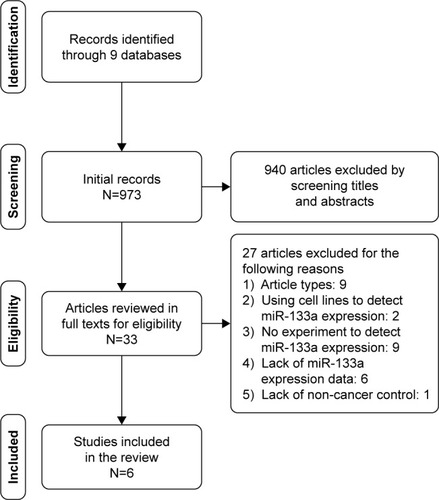
Table 1 The basic information and data of the included studies
Meta-analysis
Having searched eligible chip data, a total of 4 chips, GSE36121, GSE39093, GSE20414 and GSE2564, that contained miR-133a-3p expression data between BC and non-cancer tissues were included into the meta-analysis (). As shown in , miR-133a-3p expression was significantly lower in BC tissues than in normal tissues in the study by Zhu et al () and GSE36121 ().Citation39 All the expression data of miR-133a-3p from two literature studies and all the GEO microarray data yielded an overall SMD of −3.64 (−6.99–0.29) (),Citation38,Citation39 which indicated that miR-133a-3p expression was downregulated in BC tissues compared with that in non-cancer tissues. Due to the significant heterogeneity between chips, random-effects model was used to pool the estimates. According to the characteristics of the chip data, subgroup analysis and sensitivity analysis were chosen for tracking the source of heterogeneity. Since only six studies were included to calculate the overall SMD, meta-regression analysis was inappropriate for identifying the source of heterogeneity.Citation40,Citation41 By excluding one study each time to compare pooling effects of the remaining studies with the initial one, we found that no study exerted significant influence to the whole study cohorts (). Then, we expected to find out the source of heterogeneity by conducting subgroup analysis. We considered ethnicity and experiment type as the possible sources of heterogeneity. Unfortunately, both the subgroups of ethnicity and experiment type failed to explain heterogeneity between studies. As shown in , 95% CI of SMD for subgroups of Asian, non-Asian, other experiment and non-coding RNA profiling by array was 0, which indicated no statistical significance. With regard to the publication bias, the symmetrical funnel plot created by Begg’s test revealed that no publication bias was detected (P>0.05) (). Now that, only one literature study and all the four GEO microarray data provided detailed data of miR-133a-3p expression in each specimen, SROC was plotted based on the five qualified studies.Citation36 The area under curve (AUC) value (AUC =0.8418) () indicated that miR-133a-3p showed significant ability to differentiate BC tissues from non-cancer tissues.
Figure 3 The pattern of miR-133a-3p expression in BC tissues and normal tissues.
Abbreviation: BC, bladder cancer.
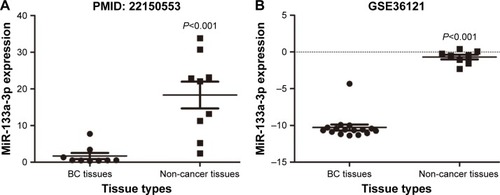
Figure 4 The forest plot of meta-analysis.
Abbreviations: SMD, standard mean difference; BC, bladder cancer; 95% CI, 95% confidence interval.
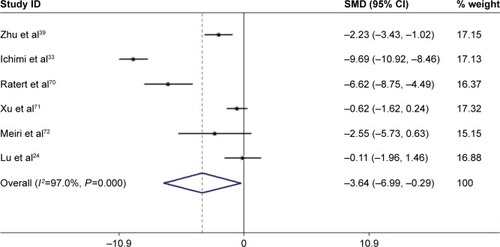
Figure 5 The sensitivity analysis.
Abbreviation: CI, confidence interval.
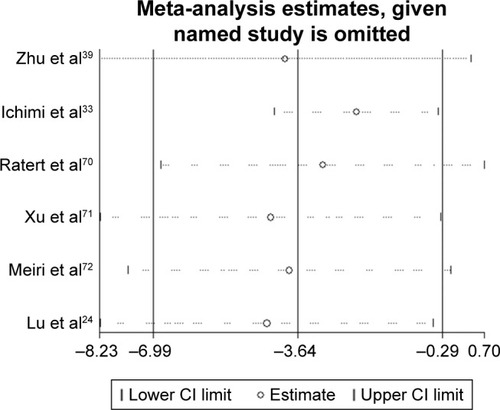
Figure 6 The publication bias.
Abbreviation: SMD, standard mean difference.
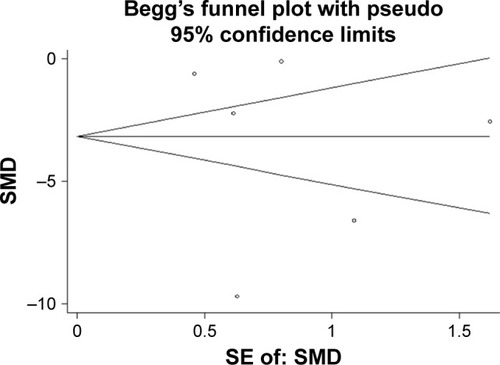
Figure 7 The SROC curve.
Abbreviations: SROC, summary receiver operating characteristic; AUC, area under curve; BC, bladder cancer.
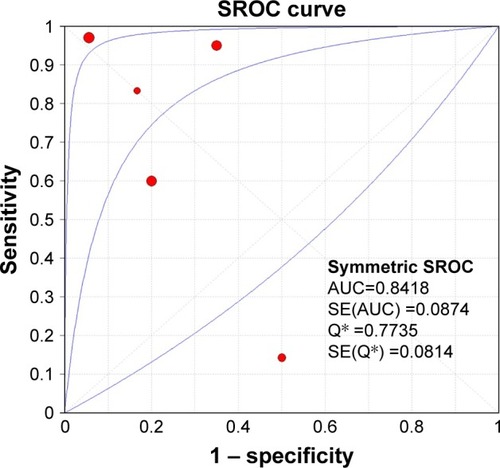
Table 2 Subgroup analysis
Potential target genes of miR-133a-3p and PPI network
From the result of 14 online software, a total of 18,103 genes were predicted to be the target genes of miR-133a-3p and 2,722 genes that appeared in more than five of the online software were screened out. Two GSM microarray chips, GSM492572 and GSM492574, were included to obtain DEGs between control cell lines and cell lines transfected with miR-133a-3p. After removing the duplicate, a total of 1976 DEGs were defined as the target genes of miR-133a-3p. Eventually, a total of 488 genes overlapping in the online software and GSM microarray chips were selected as the potential targets of miR-133a-3p. Then, we generated a PPI network comprising 110 edges and 75 nodes by putting the 488 potential target genes into STRING (). Furthermore, we identified 10 hub genes (all degrees >5), PHLPP1, ESR1, ABL1, RPS6KB1, PAK2, STK38, IGF1R, UBE2I, CDK16 and CSK, from the PPI network by calculating the degree of each node.
Figure 8 The PPI network of the target genes of miR-133a-3p.
Abbreviation: PPI, protein-protein network.
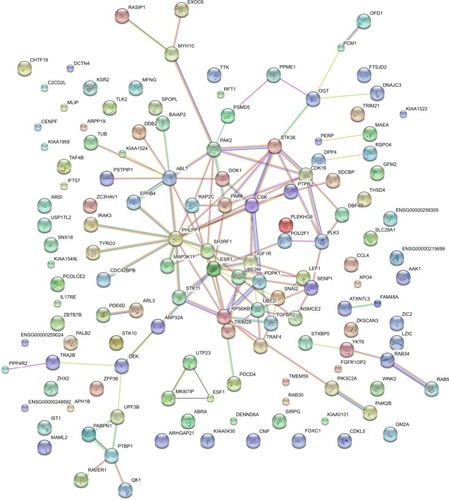
Expression of hub genes from GEPIA
Among all the 10 hub genes from PPI network, four genes, PAK2, UBE2I, CDK16 and CSK, were observed to present a higher expression in 404 BC tissues than in 28 normal tissues ().
Figure 9 Expression of hub genes in BC and normal tissues from GEPIA.
Abbreviations: BC, bladder cancer; GEPIA, Gene Expression Profiling Interactive Analysis.
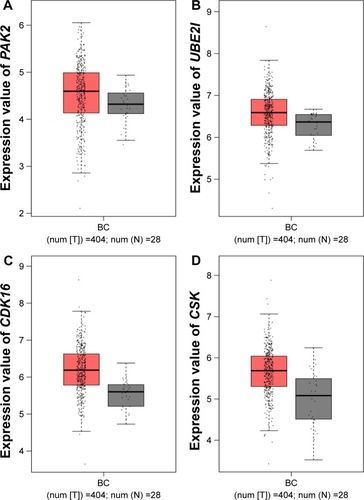
Functional and pathway enrichment analysis for target genes
According to the results from GO analysis, there were 20, 16 and 5 GO terms significantly enriched by target genes in BP, CC and MF (). The 3 most significant GO terms of BP assembled by miR-133a-3p were membrane protein ectodomain proteolysis, collagen biosynthetic process and response to oxidative stress. In CC, target genes most largely gathered in the following GO terms: extracellular exosome, focal adhesion and cytosol. As for MF, ATP binding, RNA polymerase II transcription factor activity, sequence-specific DNA binding and protein serine/threonine kinase activity were the three most significant GO terms. Moreover, three GO maps in Figures S1–S3 illustrated the interactions between the functions of target genes. Each node and link in the map represented specific GO term and interactions between them. A darker color of the node reflected a greater significance of the GO term, and sizes of the nodes indicated the number of genes assembled in each GO term.
Table 3 GO enrichment analysis of the target genes of miR-133a-3p
We also analyzed metabolic pathways of the target genes via KEGG pathway analysis. As shown in , 13 significant pathways were recorded, among which endocytosis, AMPK signaling pathway and proteoglycans in cancer were the three most significant ones.
Table 4 KEGG pathway analysis of the target genes of miR-133a-3p
Discussion
Although miR-133a-3p has been reported to inhibit the deterioration of BC and exhibit downregulated expression in BC,Citation37,Citation42,Citation43 the molecular mechanism of miR-133a-3p in BC was far from elucidated. Therefore, we validated the expression and diagnostic significance of miR-133a-3p in BC and further explored the underlying molecular mechanism through bioinformatics study.
Firstly, we searched literature studies and employed high throughput database, GEO, to mine the expression of miR-133a-3p in BC and non-cancer tissues, which is one of the highlights of our study. Meta-analysis of literature studies and GEO microarray data validated that miR-133a-3p presented significantly lower expression in BC tissues than in non-cancer tissues. Nevertheless, there was distinct heterogeneity between the included studies. Even sensitivity analysis and subgroup analysis failed to detect the source of heterogeneity. We assumed that the significant heterogeneity might originate from the different numbers of samples in BC and non-cancer bladder groups between studies or the different platforms used for the evaluation of miR-133a-3p expression. The number of samples in GEO database was obviously less than that from literature studies. Particularly, only two BC tissues and two non-cancer bladder tissues were recruited in GSE20414. Additionally, the platform for examining miR-133a-3p expression differed from one another.
Though the expression of miR-133a-3p in BC has been researched by several studies, no study up to date has evaluated the diagnostic significance of miR-133a-3p in BC. Therefore, we also explored the diagnostic ability of miR-133a-3p in BC by drawing SROC curve. The AUC value of SROC implied that miR-133a-3p might serve as a future diagnostic target for BC. Nevertheless, we collected limited number of samples; future studies with larger sample size are necessary to further assess the diagnostic ability of miR-133a-3p in BC.
Now that we have found out the diagnostic significance of miR-133a-3p expression in BC, we endeavor to clarify the underlying molecular mechanism of miR-133a-3p in BC by conducting bioinformatics study. Although previous studies have elaborated on the interaction between miR-133a-3p and several downstream targets in the pathogenesis of BC,Citation37,Citation44,Citation45 the miR-133a-3p-centered regulation network in BC remained elusive on account that a single miRNA could target multiple downstream genes involved in diversified biological process and signaling pathways. Thus, we firstly identified potential targets of miR-133a-3p. Since predicted genes of miR-133a-3p from online software might express in wide types of human tissues, potential targets of miR-133a-3p in BC were obtained from the intersection of DEGs in GEO microarray chips transfected with miR-133a-3p and the selected predicted genes from online software, which enhanced the reliability of our result. As a result, a total of 488 genes were identified as the target genes of miR-133a-3p, and we focused on the hub genes to facilitate our understanding of the functions of target genes in regulating the development of BC. According to the results from GEPIA, four of the 10 hub genes, PAK2, UBE2I, CDK16 and CSK, had a higher expression in BC tissues than in normal tissues. Since we have confirmed downregulation of miR-133a-3p in BC tissues, overexpression of the four hub genes in BC tissues proved indirectly that these genes might be targeted by miR-133a-3p. Among all the 10 hub genes, some of them such as PHLPP1, IGF1R and CSK played essential roles in the regulation of various cellular activities such as cell proliferation, survival, migration and apoptosis.Citation46–Citation48 Furthermore, IGF1R has been validated to be the target of miR-133a-3p in various cancers such as osteosarcoma, hepatocellular carcinoma and ovarian cancer.Citation25,Citation29,Citation49 In BC, IGF1R was reported to be targeted by miR-145,Citation50 which strengthened the possibility of IGF1R being targeted by miR-133a-3p. We conceived that PHLPP1, IGF1R and CSK might influence the progression of BC in several malignant aspects. Additionally, the hub genes RPS6KB1, STK38, and CDK16 engaged in specific biological processes. RPS6KB1 is a serine/threonine kinase with important roles in integrating signals related to cell growth and proliferation as well as in mediating protein synthesis.Citation51–Citation53 STK38 is a member of the AGC kinase family and its phosphorylation is pivotal for the regulation of apoptosis and cell cycle-related processes.Citation54,Citation55 CDK16 belongs to the PCTAIRE family that plays an indispensable role in cancer cell proliferation and anti-apoptosis.Citation56–Citation59 The growth, proliferation and apoptosis of cancer cells in BC might be affected by these genes as potential targets of miR-133a-3p. Although the genes ESR1 and ABL1 functioned mainly in breast cancer and chronic myeloid leukemia, they were also listed as the hub genes.Citation60,Citation61 Moreover, ESR1 expression in NMIBC was significantly different between stage and grade.Citation62 ABL1 was considered as a candidate tumor suppressor in the study by Amira et al with its significantly reduced expression in BC tissues compared with normal bladder tissues.Citation73 These findings suggested that ESR1 and ABL1 might also participate in the development of BC through some unknown interactions with miR-133a-3p. Further studies are needed to validate the interactions between miR-133a-3p and these hub genes via experiment.
To achieve a comprehensive understanding of the functions of the potential target genes, we further carried out GO annotation analysis and KEGG pathway analysis. It can be deduced from GO analysis that the target genes of miR-133a-3p exerted an influence on the progression of BC significantly by regulating biological processes such as membrane protein ectodomain proteolysis, collagen biosynthetic process and response to oxidative stress as well as MF such as ATP binding, RNA polymerase II transcription factor activity, sequence-specific DNA binding and protein serine/threonine kinase activity. Results from KEGG pathway analysis also indicated how target genes of miR-133a-3p functioned in BC. Significant pathways such as endocytosis, AMPK signaling pathway, proteoglycans in cancer and bacterial invasion of epithelial cells enlightened us that the target genes of miR-133a-3p might participate in these pathways to impact the initiation and development of BC. Among the 14 significant signaling pathways, several of them such as proteoglycans in cancer, AMPK signaling pathway, adherens junction and tight junction closely correlated with human cancers. AMPK signaling pathway plays crucial roles in cellular metabolism, preserving cellular energy homeostasis and cell apoptosis.Citation63,Citation64 There is abundant evidence supporting that AMPK is critical for the survival and growth of tumor cells.Citation65,Citation66 In BC, AMPK signaling pathway serves as a therapeutic target for certain drugs such as metformin and gefitinib, which reveal the importance of AMPK signaling pathway in BC. Adherens junction and tight junction are two pathways related to epithelial-mesenchymal transition (EMT), a process that confers invasive phenotype to various cancers.Citation67 EMT is also reported to accelerate the deterioration of BC.Citation68,Citation69 We hypothesized that the target genes of miR-133a-3p might modulate the process of EMT to influence the progression of BC.
Although this study investigated the clinical pathological significance of miR-133a-3p and explored the potential underlying molecular mechanism, it should be noted that we only hypothesized the MF of the target genes, and greater efforts are needed to verify the relationship between miR-133a-3p and the hypothesized hub genes and signaling pathways.
In summary, the present study confirmed that miR-133-a-3p acts as a tumor suppressor in BC with its downregulated expression in BC tissues. MiR-133a-3p might perform its inhibitory function in BC by regulating network of target genes through specific signaling pathways.
Acknowledgments
The study was supported by the Fund of Promoting Project of Basic Capacity for University Young and Middle-aged Teachers in Guangxi (KY2016LX034) and Innovation Project of Guangxi Graduate Education (201610598107).
Supplementary materials
Figure S1 The GO maps for BP of target genes of miR-133a-3p.
Notes: There are 69 nodes and 101 arrows in the map. GO terms of BP are represented by nodes, and the relationships between the terms are manifested by arrows. The depth of color indicates the significance of the corresponding term.
Abbreviations: GO, Gene Ontology; BP, biological process.
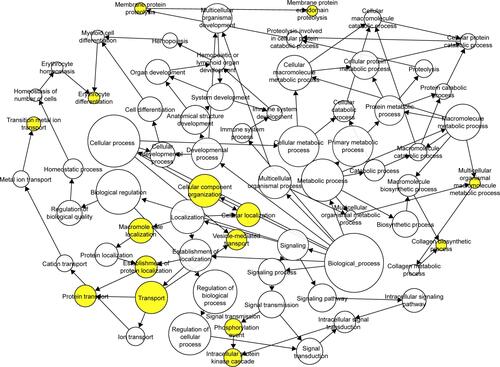
Figure S2 The GO maps for CC of target genes of miR-133a-3p.
Notes: There are 75 nodes and 130 arrows in the map. GO terms of CC are represented by nodes, and the relationships between the terms are manifested by arrows. The depth of color indicates the significance of the corresponding term.
Abbreviations: GO, Gene Ontology; CC, cellular component.
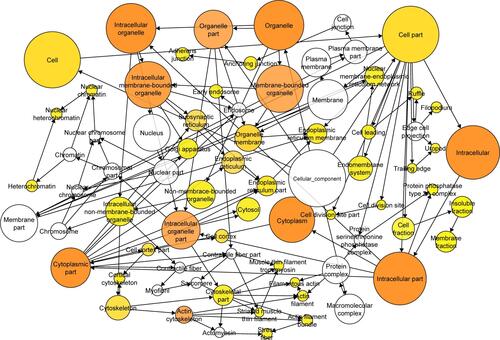
Figure S3 The GO maps for MF of target genes of miR-133a-3p.
Notes: There are 36 nodes and 41 arrows in the map. GO terms of MF are represented by nodes, and the relationships between the terms are manifested by arrows. The depth of color indicates the significance of the corresponding term.
Abbreviations: GO, Gene Ontology; MF, molecular functions.

Disclosure
The authors report no conflicts of interest in this work.
References
- TadinTKrpinaKŠtifterSBabarovićEJonjićNSignificance of uroplakin III expression in recurrence of solitary muscle non-invasive bladder cancerPathol Res Pract2014210527928424553301
- FuDLiPChengWImpact of vascular endothelial growth factor gene-gene and gene-smoking interaction and haplotype combination on bladder cancer risk in Chinese populationOncotarget2017814229272293528206971
- QiDLiJQueBLong non-coding RNA DBCCR1-003 regulate the expression of DBCCR1 via DNMT1 in bladder cancerCancer Cell Int2016168127777512
- XiaoJLinHYZhuYYZhuYPChenLWMiR-126 regulates proliferation and invasion in the bladder cancer BLS cell line by targeting the PIK3R2-mediated PI3K/Akt signaling pathwayOnco Targets Ther201695181519327578985
- GilDCiołczyk-WierzbickaDDulińska-LitewkaJLaidlerPIntegrin-linked kinase regulates cadherin switch in bladder cancerTumour Biol20163711151851519127683053
- WuZWangCZhangZHigh expression of Derlin-1 is associated with the malignancy of bladder cancer in a Chinese Han populationPLoS One20161112e016835127977784
- CuiXShenDKongCNF-kB suppresses apoptosis and promotes bladder cancer cell proliferation by upregulating survivin expression in vitro and in vivoSci Rep201774072328139689
- HeideggerITulchinerGSchäferGHorningerWPichlerRLong term disease free survival with multimodal therapy in small cell bladder cancerEur J Med Res20162114027737712
- YuYLiXLiangCThe relationship between GSTA1, GSTM1, GSTP1, and GSTT1 genetic polymorphisms and bladder cancer susceptibility: a meta-analysisMedicine (Baltimore)20169537e490027631264
- DuJWangSHYangQChenQQYaoXp53 status correlates with the risk of progression in stage T1 bladder cancer: a meta-analysisWorld J Surg Oncol20161413727129876
- SiegelRLMillerKDJemalACancer Statistics, 2017CA Cancer J Clin201767173028055103
- VashisthaVQuinnDIDorffTBDaneshmandSCurrent and recent clinical trials for perioperative systemic therapy for muscle invasive bladder cancer: a systematic reviewBMC Cancer20141496625515347
- MalmströmPUWijkströmHLundholmCWesterKBuschCNorlénBJ5-year followup of a randomized prospective study comparing mitomycin C and bacillus Calmette-Guerin in patients with superficial bladder carcinoma. Swedish-Norwegian Bladder Cancer Study GroupJ Urol199916141124112710081852
- TsujiSChenXHancockBPreclinical evaluation of VAX-IP, a novel bacterial minicell-based biopharmaceutical for nonmuscle invasive bladder cancerMol Ther Oncolytics201631600427119118
- YeFWangLCastillo-MartinMBiomarkers for bladder cancer management: present and futureAm J Clin Exp Urol20142111425374904
- BartelDPMicroRNAs: genomics, biogenesis, mechanism, and functionCell2004116228129714744438
- BartelDPChenCZMicromanagers of gene expression: the potentially widespread influence of metazoan microRNAsNat Rev Genet20045539640015143321
- HuangYLiXTaoGZhuTLinJComparing serum microRNA levels of acute herpes zoster patients with those of postherpetic neuralgia patientsMedicine (Baltimore)2017968e599728225487
- WangCLiaoHCaoZRole of osterix and microRNAs in bone formation and tooth developmentMed Sci Monit2016222934294227543160
- ZhouYLXuYJQiaoCWMiR-34c-3p suppresses the proliferation and invasion of non-small cell lung cancer (NSCLC) by inhibiting PAC1/MAPK pathwayInt J Clin Exp Pathol2015866312632226261507
- YangGZhangXShiJMiR-98 inhibits cell proliferation and invasion of non-small cell carcinoma lung cancer by targeting PAK1Int J Clin Exp Med2015811201352014526884926
- KimVNMicroRNA biogenesis: coordinated cropping and dicingNat Rev Mol Cell Biol20056537638515852042
- ShiMLiuDDuanHShenBGuoNMetastasis-related miRNAs, active players in breast cancer invasion, and metastasisCancer Metastasis Rev201029478579920938719
- LuJGetzGMiskaEAMicroRNA expression profiles classify human cancersNature2005435704383483815944708
- GuoJXiaBMengFLouGmiR-133a suppresses ovarian cancer cell proliferation by directly targeting insulin-like growth factor 1 receptorTumour Biol20143521557156424127040
- DongYZhaoJWuCWTumor suppressor functions of miR-133a in colorectal cancerMol Cancer Res20131191051106023723074
- CuiWZhangSShanCZhouLZhouZmicroRNA-133a regulates the cell cycle and proliferation of breast cancer cells by targeting epidermal growth factor receptor through the EGFR/Akt signaling pathwayFEBS J2013280163962397423786162
- KojimaSChiyomaruTKawakamiKTumour suppressors miR-1 and miR-133a target the oncogenic function of purine nucleoside phosphorylase (PNP) in prostate cancerBr J Cancer2012106240541322068816
- ZhangWLiuKLiuSJiBWangYLiuYMicroRNA-133a functions as a tumor suppressor by targeting IGF-1R in hepatocellular carcinomaTumour Biol201536129779978826156803
- ChenXBoLZhaoXChenQMicroRNA-133a inhibits cell proliferation, colony formation ability, migration and invasion by targeting matrix metallopeptidase 9 in hepatocellular carcinomaMol Med Rep20151153900390725607810
- ZhouYWuDTaoJQuPZhouZHouJMicroRNA-133 inhibits cell proliferation, migration and invasion by targeting epidermal growth factor receptor and its downstream effector proteins in bladder cancerScand J Urol201347542343223206218
- SongTXiaWShaoNDifferential miRNA expression profiles in bladder urothelial carcinomasAsian Pac J Cancer Prev201011490591121133599
- IchimiTEnokidaHOkunoYIdentification of novel microRNA targets based on microRNA signatures in bladder cancerInt J Cancer2009125234535219378336
- HigginsJPThompsonSGDeeksJJAltmanDGMeasuring inconsistency in meta-analysesBMJ2003327741455756012958120
- TangZLiCKangBGaoGLiCZhangZGEPIA: a web server for cancer and normal gene expression profiling and interactive analysesNucleic Acids Res Epub2017412
- PignotGCizeron-ClairacGVacherSmicroRNA expression profile in a large series of bladder tumors: identification of a 3-miRNA signature associated with aggressiveness of muscle-invasive bladder cancerInt J Cancer2013132112479249123169479
- YoshinoHChiyomaruTEnokidaHThe tumour-suppressive function of miR-1 and miR-133a targeting TAGLN2 in bladder cancerBr J Cancer2011104580881821304530
- HanYChenJZhaoXMicroRNA expression signatures of bladder cancer revealed by deep sequencingPLoS One201163e1828621464941
- ZhuJJiangZGaoFA systematic analysis on DNA methylation and the expression of both mRNA and microRNA in bladder cancerPLoS One2011611e2822322140553
- HigginsJThompsonSDeeksJAltmanDStatistical heterogeneity in systematic reviews of clinical trials: a critical appraisal of guidelines and practiceJ Health Serv Res Policy200271516111822262
- SchmidCHStarkPCBerlinJALandaisPLauJMeta-regression detected associations between heterogeneous treatment effects and study-level, but not patient-level, factorsJ Clin Epidemiol200457768369715358396
- UchidaYChiyomaruTEnokidaHMiR-133a induces apoptosis through direct regulation of GSTP1 in bladder cancer cell linesUrol Oncol201331111512321396852
- WeiYHeRWuYComprehensive investigation of aberrant microRNA profiling in bladder cancer tissuesTumour Biol2016379125551256927350368
- ChiyomaruTEnokidaHTataranoSmiR-145 and miR-133a function as tumour suppressors and directly regulate FSCN1 expression in bladder cancerBr J Cancer2010102588389120160723
- YamasakiTYoshinoHEnokidaHNovel molecular targets regulated by tumor suppressors microRNA-1 and microRNA-133a in bladder cancerInt J Oncol20124061821183022378464
- HouYDengJZhangLLower expression of PH domain leucine-rich repeat protein phosphatase 1 (PHLPP1) association with poor prognosis of gastric cancerInt J Clin Exp Med2015811204812048926884964
- Ter BraakBSiezenCLLeeJSInsulin-like growth factor 1 receptor activation promotes mammary gland tumor development by increasing glycolysis and promoting biomass productionBreast Cancer Res20171911428173837
- QayyumTFyffeGDuncanMThe interrelationships between Src, Cav-1 and RhoGD12 in transitional cell carcinoma of the bladderBr J Cancer201210661187119522353809
- ChenGFangTHuangZMicroRNA-133a inhibits osteosarcoma cells proliferation and invasion via targeting IGF-1RCell Physiol Biochem201638259860826845446
- ZhuZXuTWangLMicroRNA-145 directly targets the insulin-like growth factor receptor I in human bladder cancer cellsFEBS Lett2014588173180318524999188
- KhotskayaYBGoverdhanAShenJS6K1 promotes invasiveness of breast cancer cells in a model of metastasis of triple-negative breast cancerAm J Transl Res20146436137625075253
- FleckensteinDSDirksWGDrexlerHGQuentmeierHTumor necrosis factor receptor-associated factor (TRAF) 4 is a new binding partner for the p70S6 serine/threonine kinaseLeuk Res200327868769412801526
- de GrootRPBallouLMSassone-CorsiPPositive regulation of the cAMP-responsive activator CREM by the p70 S6 kinase: an alternative route to mitogen-induced gene expressionCell199479181917923380
- HergovichAStegertMRSchmitzDHemmingsBANDR kinases regulate essential cell processes from yeast to humansNat Rev Mol Cell Biol20067425326416607288
- HergovichARegulation and functions of mammalian LATS/NDR kinases: looking beyond canonical Hippo signallingCell Biosci2013313223985307
- ColeARPCTK proteins: the forgotten brain kinases?Neurosignals200917428829719816065
- YanagiTKrajewskaMMatsuzawaSReedJCPCTAIRE1 phosphorylates p27 and regulates mitosis in cancer cellsCancer Res201474205795580725205104
- YanagiTReedJCMatsuzawaSPCTAIRE1 regulates p27 stability, apoptosis and tumor growth in malignant melanomaOncoscience201411062463325593992
- YanagiTMatsuzawaSPCTAIRE1/PCTK1/CDK16: a new oncotarget?Cell Cycle201514446346425590439
- LiTZhaoJYangJA meta-analysis of the association between ESR1 genetic variants and the risk of breast cancerPLoS One2016114e015331427070141
- LyuXYangJWangXA novel BCR-ABL1 fusion gene identified by next-generation sequencing in chronic myeloid leukemiaMol Cytogenet201694727350795
- BreyerJWirtzRMLaibleMESR1, ERBB2, and Ki67 mRNA expression predicts stage and grade of non-muscle-invasive bladder carcinoma (NMIBC)Virchows Arch2016469554755227514658
- HardieDGAlessiDRLKB1 and AMPK and the cancer-metabolism link – ten years afterBMC Biol2013113623587167
- LiangJMillsGBAMPK: a contextual oncogene or tumor suppressor?Cancer Res201373102929293523644529
- SteinbergGRKempBEAMPK in health and diseasePhysiol Rev20098931025107819584320
- ViolletBHormanSLeclercJAMPK inhibition in health and diseaseCrit Rev Biochem Mol Biol201045427629520522000
- WiklundEDBramsenJBHulfTCoordinated epigenetic repression of the miR-200 family and miR-205 in invasive bladder cancerInt J Cancer201112861327133420473948
- ZhuBQiLLiuSCLASP2 is involved in the EMT and early progression after transurethral resection of the bladder tumorBMC Cancer201717110528166762
- WangXLiangZXuXmiR-148a-3p represses proliferation and EMT by establishing regulatory circuits between ERBB3/AKT2/c-myc and DNMT1 in bladder cancerCell Death Dis2016712e250327906180
- RatertNMeyerHAJungMReference miRNAs for miRNAome analysis of urothelial carcinomasPLoS One201276e3930922745731
- XuCZengQXuWmiRNA-100 inhibits human bladder urothelial carcinogenesis by directly targeting mTORMol Cancer Ther201312220721923270926
- MeiriELevyABenjaminHDiscovery of microRNAs and other small RNAs in solid tumorsNucleic Acids Research201038186234624620483914
- AmiraNCancel-TassinGBernardiniSExpression in bladder transitional cell carcinoma by real-time quantitative reverse transcription polymerase chain reaction array of 65 genes at the tumor suppressor locus 9q34.1-2: identification of 5 candidates tumor suppressor genesInt J Cancer2004111453954215239131
